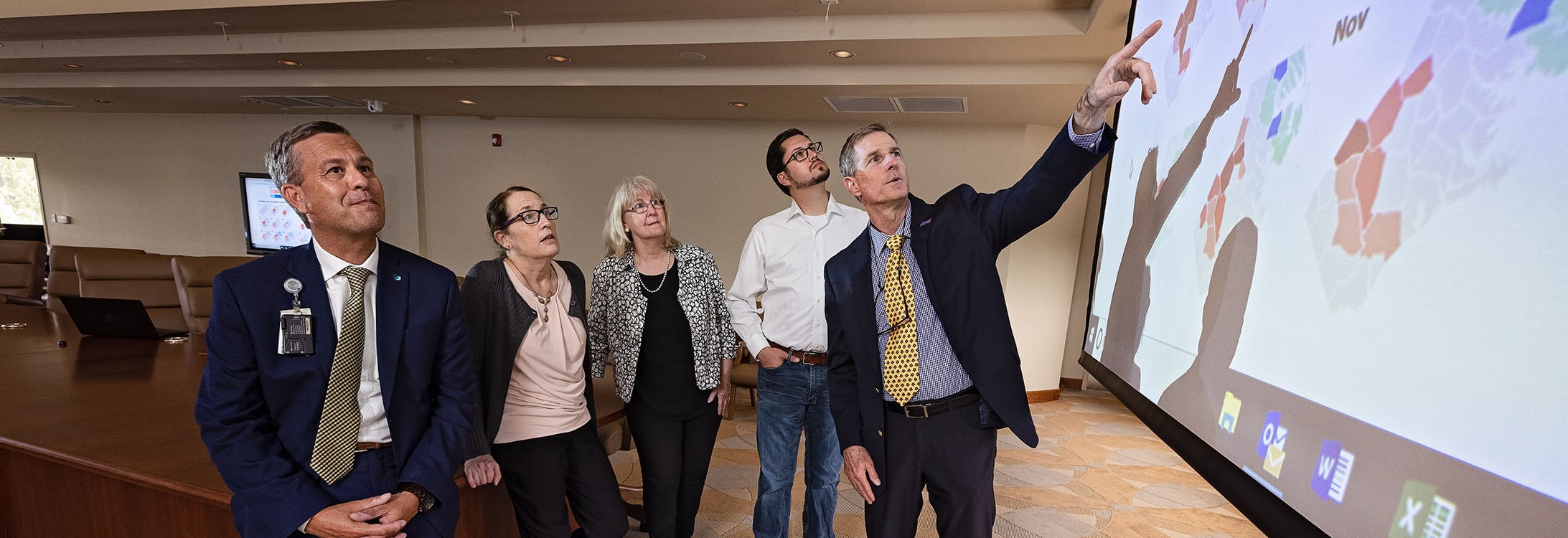MAPPING COVID-19
ECU, Vidant and Dartmouth partnership targeted ethical vaccine distribution
When limited resources prevent everyone from having immediate access to COVID-19 vaccines, how do you determine who needs them most urgently? Where are they located? How can you get the vaccine to them, and if you do, will they want it?
These were among the questions that a team from East Carolina University, Vidant Health and Dartmouth College came together to answer.
Supported by CARES Act funding provided through the North Carolina General Assembly, ECU faculty experts and students in public health, geography, health information management, bioethics, psychology and folklore partnered with professionals from Vidant and faculty from Dartmouth to design tools that provide insight into the distribution of COVID-19-related resources ethically and efficiently. Those tools have since been used to help reduce the spread of COVID-19 and guide vaccination efforts throughout eastern North Carolina.
Amid the ongoing pandemic, ECU faculty experts worked with leaders from Vidant to quickly identify the locations of vulnerable populations, the facilities at the highest risk and the need for COVID-19 vaccines across eastern N.C.
Meanwhile, bioethics faculty and authorities in health disparities shared information and context on the different populations in the state’s eastern region, their beliefs and biases related to vaccines, and created a framework for equitable vaccine distribution strategies. Others in the group are examining attitudes and beliefs about COVID-19 and the vaccines throughout the region.
The group of nearly 20 experts met via web conferences every Friday for over five months, assessing coronavirus case rates, identifying hot spots in the region and building a website to inform healthcare providers, public health officials and the general public. Among the many efforts that resulted from the inter-disciplinary collaboration were the ENCHealth.org website and the first of its kind Vaccine Priority Index (VPI) mapping tool.
The unique, web-based VPI mapping tool created by ECU and Vidant readily assists health care providers and health departments by identifying the highest-risk, priority populations and their locations across eastern North Carolina. The VPI uses a computed ranking index score to identify the locations of the most vulnerable populations for prioritizing vaccine delivery.
The tool displays all 100 North Carolina counties and Census tracts by their COVID-19 risk priority as reflected in the N.C. Department of Health and Human Services’ vaccine rollout plan groupings released earlier this year.
“We really wanted the ENC Health website and the tools we developed to be a one-stop shop for information about health and COVID-19 in eastern NC,” said Dr. Greg Kearney, associate professor in the Brody School of Medicine’s Department of Public Health and the project’s principal investigator. “The funding and efforts for this project capitalized on Vidant’s data and ECU’s technical expertise. As a result, both Vidant and ECU worked together to create unique products and bolstered our mission statements, by serving eastern N.C. communities.”
ENCHealth.org provides interactive mapping tools intended to help health officials, students and the general public identify and understand COVID-19 hot spot development and patterns throughout the region. A team from the Dartmouth Atlas Project assisted in the process by helping develop the website, adding tools and branding it specifically for eastern North Carolina.
The website also illustrates the prevalence of COVID-19 cases across North Carolina, featuring a “weather forecast” model that allows users to predict or estimate the number of cases in each county in the future. Other features include a tool that allows users to find COVID-19 testing sites nearest to them, the number of COVID-19 cases at other universities and colleges, the rates of COVID-19-like and influenza-like illness in the region, and other COVID-19 related scholarly work.
“Our goal was really to make sure that the least amount of people were negatively affected, and we were totally aware that rural folks were not going to fare well, that we had huge health disparities in the East,” said Dr. Maria Clay, professor and chair of the Department of Bioethics and Interdisciplinary Studies in the Brody School of Medicine and co-principal investigator on the project. “We wanted to make sure that their voices, their issues got elevated and that they didn’t get lost.”
So, where exactly is COVID-19 in ENC? And where are those people relative to the resources they need?
To illustrate the spread of COVID-19 across eastern North Carolina in real time, ECU faculty experts in public health, geography and information management teamed with leadership from Vidant. Through an approved IRB and data sharing agreement between Vidant and ECU, the group was able to use de-identified hospital data to identify the location of COVID-19 cases throughout the region. Using statistical and mapping software, the team was able to detect and illustrate the areas of COVID-19 hot spots across the East.
“We initially found clustering in some suspected areas such as nursing homes and more densely concentrated areas. With more work, we uncovered some hot spots in neighborhood areas near campus which correlated with the start of school last August when classes started back,” Kearney said.
The mapping tools developed by the team preceded some of the more high-profile tools released by state and national entities.
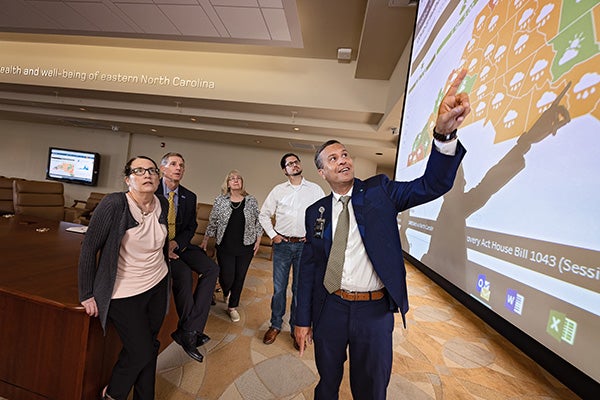
Vidant Health’s Bennett Wall, far right, gestures toward the “weather map” developed to help the public easily understand the risk of COVID-19 by county. The map also uses data to predict future risk potential in these areas.
The CARES Act funding allowed the project to expand and explore how the mapping capabilities that the team developed originally could be used to identify where the vaccine was most needed — in vulnerable populations and high-risk groups.
“We basically built off the idea of an already existing mapping tool from CDC that was being used to prioritize population vulnerability to natural disasters,” Kearney said. “We asked ourselves, ‘What if we were to change the data up a bit, and instead of responding to a natural disaster as an outcome, we prioritized population vulnerability and the need for vaccine?’ So, if a health department director is getting these large doses of vaccine and needs to allocate, distribute or prioritize it, they can quickly find out where these vulnerable populations are located.”
Meanwhile, as the state and federal government released updates on vaccine prioritization groups and eligibility, the collaborators also began mapping where the people within the groups deemed eligible were located and how close they were to resources such as health care offices where they could receive a vaccine. They also mapped the exact street address locations of high-risk facilities like nursing homes, prisons and meat packing plants where most outbreaks were occurring.
“We were interested in identifying, early on, where people were in relationship to resources,” Clay said. “So, where were people in relationship to health care services, in relationship to pharmacies and the like?”
“We were able to identify these COVID-19 hot spot areas and alert Vidant and public health folks that needed this information,” Kearney said. “Our team thought about how we would reach our goals early on in the process, meeting often and communicating each step of the way. It was literally like drinking from a firehose, there were so many aspects to what we were trying to accomplish, but the team completed everything we set out to do in about five months.”
How do you determine what’s “fair” when it comes to vaccine distribution?
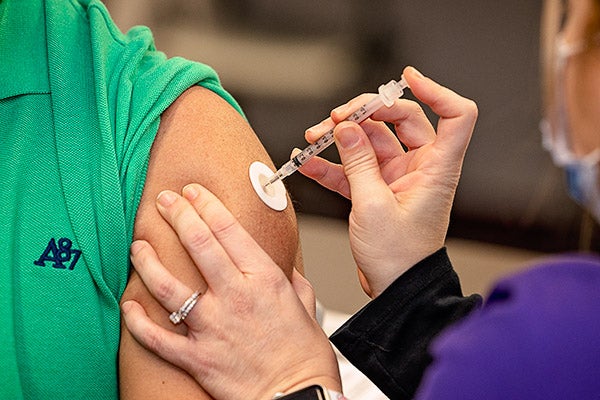
Experts from ECU, Vidant and Dartmouth worked together to determine how to ethically distribute COVID-19 vaccines.
Among the team tasked with reducing COVID-19’s impact across the region are faculty experts in bioethics and health disparities who developed an Ethical Vaccine Distribution Framework.
“We looked at it in terms of accountability, utilitarianism, issues of distributive justice,” said Dr. Hugh Lee, teaching professor in the Department Bioethics and Interdisciplinary Studies.
The more the group considered the different ethical lenses through which the problem could be viewed, the more they realized that a truly ethical and just distribution of vaccine requires the process to be split into two pieces: determining the rules that help decide who gets the vaccine when, and identifying the ethical principles that help determine those rules.
“When we decide how we distribute that vaccine to the groups that we have decided have priority, what are the ethical ramifications of those choices, and how can we distribute the vaccine in a way that is defensible, that promotes public trust and transparency and that ensures that society as a whole has a strong foundational belief in the process by which this scarce resource is being distributed?” Lee said.
The group provided its recommendations about the set of principles that should guide these decisions to Vidant Health and to the state’s vaccine distribution work group. They are currently writing an article explaining the underlying principles and need to promote the distribution of vaccine process in a way that society can understand, accept and trust.
What do eastern North Carolinians think about the vaccines?
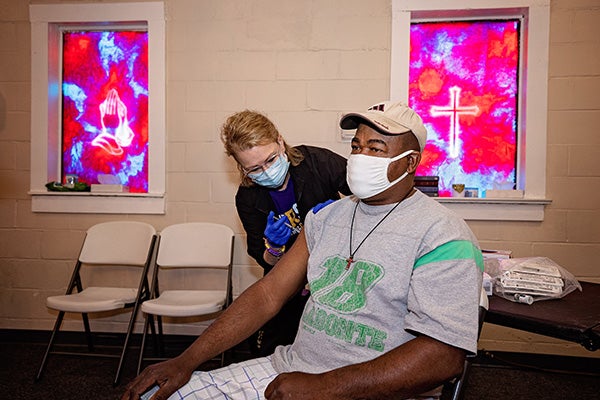
“Community Voices in COVID-19” is a project aimed at gathering information on eastern North Carolinians’ opinions about COVID-19 and the vaccines.
While some members of the group were tracking the virus’ spread across the East, others were tracking the spread of misinformation about the vaccines. “Community Voices in COVID-19” takes a qualitative approach to gathering information about eastern North Carolinians’ opinions about the virus and vaccines. What are their concerns when it comes to COVID-19 and why do they plan — or not — to get vaccinated against it?
“We knew early on that the vaccine would have people who were hesitant to take it for a variety of reasons, in terms of historical issues, disparities issues, political issues, environmental and logistical issues,” Clay said. “We wanted to reach out and talk to folks about their reluctance or enthusiasm for taking the vaccine. We just wanted to hear from them.”
As faculty interviewed eastern North Carolinians and expanded their scope to include students assisting with the surveys, they found that not much was known about the opinions of college-aged students related to COVID-19.
“We realized that an under-surveyed group are young adults, and specifically college students. We weren’t sure what their views on COVID and the COVID vaccine were,” Clay said. “So, since February, we have been developing an instrument to survey college students, particularly ours, to find out if they’re saying the same thing that our ‘COVID Voices’ folks did. Are they saying the same thing that people in the media are saying? We don’t know if that pertains to 18-25-year-olds or not.”
This project is ongoing.
How do we apply what we’ve learned to help our region?
Because of Vidant’s involvement with the project, the team’s findings were able to be put into practice immediately, and their work already has helped save lives throughout the East.
Aided by the mapping technologies they developed, Vidant has been able to identify and monitor hot spots and risk areas more easily and to disperse health care providers and other needed resources to those areas more quickly, resulting in fewer cases and deaths.
The team’s “SWARM” approach, published in the SCIEDU Journal of Hospital Administration, was developed to help nursing and adult care homes reduce or prevent outbreaks and risks related to COVID-19 across eastern North Carolina. The homes included in this approach (those under Vidant’s service umbrella throughout the region) experienced fewer average COVID-19-related resident cases and deaths compared with others across the state. The length of outbreak recovery time was also far shorter among facilities using this approach.
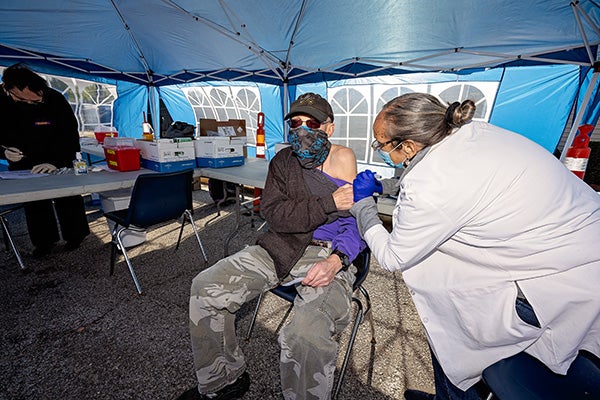
Because of the tools developed during the collaboration, Vidant has been able to identify and monitor hot spots and risk areas more easily and to disperse health care providers and other needed resources to those areas more quickly, resulting in fewer cases and deaths from COVID-19.
“A lot of our targeted mitigation strategies that were coming from our SWARM team were driven from our data that were coming out of where our hot spots were,” said Bennett Wall, Vidant’s director of women’s and children’s service line development for Vidant and a lead member of the SWARM team. “The website, our data and the Social Vulnerability Index scores are providing us keen insights, knowing where our small geographies of high-risk patient populations are based on their socio-economic status so that we can target mitigation strategies — at that point in time it was for reducing COVID spread. Now it’s getting people vaccinated and improving wellness.”
Wall said the maps have also been able to help Vidant identify where to send mobile billboards – trucks with digital displays carrying important messages about masking or other preventive measures – that alerts community members when they’re in COVID-19 hotspots. The mobile billboards, in addition to other marketing tactics like door hangers and flyers, helped local communities respond to increased spread.
Moving forward, Wall said the team is exploring ways the tools and partnerships developed can be built on and further used to help provide better access to other types of health care unrelated to COVID-19.
“Is it better for us to set up a standard bus route to West Greenville and go ahead and schedule clinic visits? — because we know transportation limitation is a big reason people can’t get medication refilled and can’t get to doctor appointments. Do we target certain geographies for including an Uber ride when you schedule an appointment? So, when we set up an appointment for you, we schedule your Uber ride at the same time. Those are the types of things that can be imagined to help patients when you get into a geospatial data world,” Wall said.
Approaching a large-scale public health event that initially presented more questions than answers seemed daunting at first. That’s when health care experts and entities familiar with eastern North Carolina joined forces and lent their strongest resources to mitigating the pandemic’s consequences on the region. Those bridges will endure.
“Vidant brings real-world problems and data to the table,” Wall said. “ECU brings experts in academia and they bring bandwidth in the form of PhD students and master’s degree students that can do this work.
“When you can put everybody’s personal interests aside and have a common goal, the sky’s the limit.”
